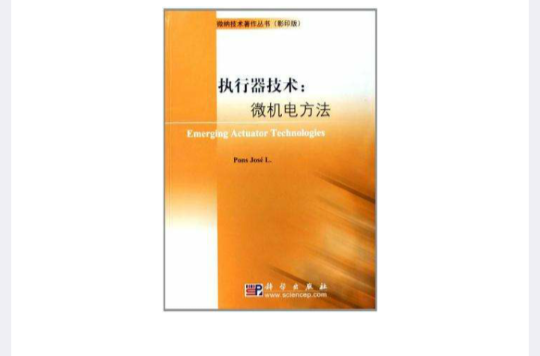內容簡介
執行器是將電能轉換成機械能的裝置,通常用於電氣、氣動、液壓系統。由於執行器技術在生物醫學、人工器官修復、器械矯形中套用的需要,對高效且具有微納米尺寸級別的複雜精密機械產品的需要不斷增長。
《執行器技術:微機電方法(影印版)》對執行器的新套用進行了全面的介紹,內容包括:介紹了壓電執行器、形狀記憶執行器、磁致伸縮執行器的機電一體化設計、控制、集成技術;檢驗了微納米級別新興執行器的特性和性能;評估了各種執行器技術的優點,勾畫了今後的套用領域。
編輯推薦
《執行器技術:微機電方法》可供從事微納器件設計製造領域的科研人員、工程師參考。
圖書目錄
1 Actuators in motion control systems: mechatronics
1.1 What is an actuator?
1.2 Transducing materials as a basis for actuator design
1.2.1 Energy domains and transduction phenomena
1.2.2 Transducer basics
1.3 The role of the actuator in a control system: sensing, processing and acting
1.3.1 Sensing
1.3.2 Processing
1.3.3 Actuation
1.3.4 Impedance matching
1.4 What is mechatronics? Principles and biomimesis
1.4.1 Principles
1.4.2 Mechatronics and biomimesis
1.5 Concomitant actuation and sensing: smart structures
1.6 Figures of merit of actuator technologies
1.6.1 Dynamic performance
1.6.2 Actuator behavior upon scaling
1.6.3 Suitability for the application
1.6.4 Static performance
1.6.5 Impact of environmental parameters
1.7 A classification of actuator technologies
1.7.1 Semiactive versus active actuators
1.7.2 Translational versus rotational actuators
1.7.3 Input energy domain
1.7.4 Soft versus hard actuators
1.8 Emerging versus traditional actuator technologies
1.9 Scope of the book: emerging actuators
1.10 Other actuator technologies
1.10.1 Electrostatic actuators
1.10.2 Thermal actuators
1.10.3 Magnetic shape memory actuators
2 Piezoelectric actuators
2.1 Piezoelectricity and piezoelectric materials
2.2 Constitutive equations of piezoelectric materials
2.3 Resonant piezoelectric actuators
2.3.1 Basics of resonant operation of piezoelectric loads...
2.3.2 Rotational ultrasonic motors
2.3.3 Linear ultrasonic motors
2.4 Nonresonant piezoelectric actuators
2.4.l Bimorph actuators
2.4.2 Stack piezoelectric actuators
2.4.3 Inchworm actuators
2.5 Control aspects of piezoelectric motors
2.5.1 Control circuits and resonant drivers
2.5.2 Control of nonresonant actuators
2.6 Figures of merit of piezoelectric actuators
2.6.1 Operational characteristics
2.6.2 Scaling of piezoelectric actuators
2.7 Applications
2.7.1 Applications of resonant piezoelectric actuators
2.7.2 Applications of nonresonant piezoelectric actuators
3 Shape Memory Actuators (SMAs)
3.1 Shape memory alloys
3.1.1 The shape memory effect
3.1.2 Pseudoelasticity in SMAs
3.2 Design of shape memory actuators
3.2.1 Design concepts for actuation with SMAs
3.2.2 Material considerations
3.2.3 Thermal considerations
3.3 Control of SMAs
3.3.1 Electrical heating
3.3.2 Concomitant sensing and actuation with SMAs
3.3.3 Integration in control loops
3.4 Figures of merit of shape memory actuators
3.4.1 Operational ranges
3.4.2 Scaling laws for SMA actuators
3.5 Applications
4 Eiectroactive polymer actuators (EAPs)
4.1 Principles
4.1.1 Wet EAP actuators
4.1.2 Dry EAP actuators
4.2 Design issues
4.3 Control of EAPs
4.4 Figures of merit of EAPs
4.4.1 Operational characteristics
4.4.2 Scaling laws for EAPs
4.5 Applications
5 Magnetostrictive actuators (MSs)
5.1 Principles of magnetostriction
5.1.1 Historical perspective
5.1.2 Basics of magnetic properties of materials
5.1.3 Magnetostriction: constitutive equations
5.2 Magnetostrictive materials: giant magnetostriction
5.2.1 Positive versus negative magnetostriction: effect of the load
5.2.2 A Y-Effect in magnetostrictive materials
5.3 Design of magnetostrictive actuators
5.3.1 Design for improved stroke
5.3.2 Design for linearized, push-pull operation
5.3.3 Design of electric and magnetic circuits
5.3.4 Design for selected resonance characteristics
5.4 Control of magnetostrictive actuators: vibration absorption
5.4.1 Active vibration suppression
5.4.2 Smart actuators and smart structures
5.4.3 Combined sensing and actuation
5.5 Figures of merit of MS actuators
5.5.1 Operational range
5.5.2 Scaling laws for magnetostriction
5.6 Applications
6 Electro- and magnetorheological actuators (ERFs, MRFs)
6.1 Active rheology: transducing materials
6.1.1 Basics of rheology :
6.1.2 Field-responsive fluids
6.1.3 Electro- and magnetorheology
6.2 Mechatronic design concepts
6.2.1 Shear, flow and squeeze modes
6.2.2 Device dimensions according to specifications
6.2.3 Driving electronics for ER and MR devices
6.2.4 Design of magnetic circuits in MR devices
6.3 Control of ERF and MRF
6.3.1 Sky-hook vibration isolation
6.3.2 Relative vibration isolation
6.4 Figures of merit of ER and MR devices...
6.4.1 Material aspects
6.4.2 Size and weight of ER and MR devices
6.4.3 Available dissipative force and power
6.4.4 Scaling of active rheology concepts
6.5 Applications
7 Summary, conclusions and outlook
7.1 Brief summary
7.1.1 Piezoelectric actuators
7.1.2 Shape memory alloy actuators
7.1.3 Electroactive polymer actuators
7.1.4 Magnetostrictive actuators
7.1.5 Electro- and Magnetorheological fluid actuators
7.1.6 Example applications: case studies
7.2 Comparative position of emerging actuators
7.2.1 Comparative analysis in terms of force
7.2.2 Comparative analysis in terms of force density
7.2.3 Comparative analysis in terms of stroke
7.2.4 Comparative analysis in terms of work density per cycle
7.2.5 Comparative analysis in terms of power density
7.2.6 Comparative analysis in terms of bandwidth
7.2.7 Relative position in the static and dynamic plane
7.2.8 Comparison in terms of scaling trends
7.2.9 Concluding remarks
7.3 Research trends and application trends
7.3.1 Piezoelectric actuators
7.3.2 Shape memory alloy actuators
7.3.3 Electroactive polymer actuators
7.3.4 Magnetostrictive actuators
7.3.5 Electro- and Magnetorheological fluid actuators
Bibliography
Index

